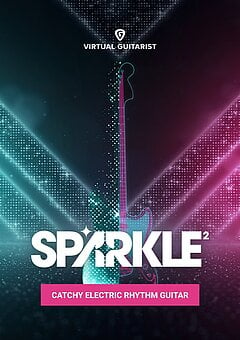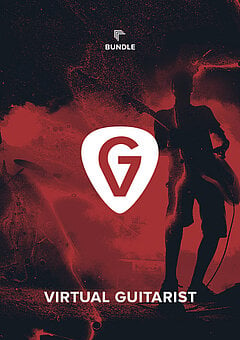How to Use Open Chords to Spice Up Your Guitar Parts
SPARKLE 2’s unique new feature provides even more variety and makes it easier than ever to sit electric guitar perfectly in the mix.
OCTOBER 28TH, 2022
This article is a quick overview of open chords and how they can be used to spice up guitar parts in your track with SPARKLE 2:
What are open chords?
One of the new features included in SPARKLE 2 is the ability to use open chord voicings to expand your harmonic palette when producing songs. To understand this concept, imagine playing a C major chord on the piano — “closed” voicing, C-E-G played with the left hand and an octave above in the right. While this chord works just fine and is the best option for the job in many cases, it’s cluttered by nature. Now imagine stretching your thumb and pinky in each hand to reach over an octave — C-G-E in each hand. You’re still playing six notes, but over the range of more than three octaves versus less than two. This sound can feel bigger, grander, and of course, more “open” ... hence the name!
This is trickier to visualize on a guitar and the notes won’t be exactly the same due to the tuning of the strings, but the concept is applied the same way. By putting more space between the notes, you can achieve a different sound from the guitar and add a ton of variety to your guitar parts. Another benefit to this is that by spreading out the notes, there’s less clutter in each octave ... and reduced clutter makes for a much easier experience mixing! Due to the guitar’s construction, open chords take a slightly different form from the straightforward approach seen with the piano, but don’t worry — we’ll cover everything you need to know in the sections below.
Now that we’ve covered a bit about the uses of open chord voicings, let’s see how to use them in practice.
Open chords on guitar
With open guitar chords, there’s an important distinction from the piano example above: The range of a guitar is less than that of a piano, so it’s not possible to create the exact same voicings. Coupled with the fact that distorting an electric guitar generally creates more muddiness as you add notes to a chord, it might seem like open chords aren’t possible; the way around this is to drop notes from the chord. For example, in an Ab major 7th chord (Ab-C-Eb-G), a guitarist might play what sounds like a C power (C-G) or minor (C-Eb-G) chord, but when combined with other instruments that collectively fill out the rest of the chord, the result is clear and full and allows you create an amazing arrangement!
After clicking the “Open Chords” option on SPARKLE 2’s interface, you’ll notice quickly that many of the chords sound incomplete, and the bass range is often missing. For passages where the guitar leads the band and needs maximum low-end anchoring, this means that the default option might be better suited to your needs. Closer, simpler voicings will help lock everything in. However, if you have bass, piano, drums, synths and more all playing at the same time, this is a great opportunity to try out the Open Chords option and accent what’s already there rather than pushing the guitar to take center stage.
There’s a fun hybrid of this that can also give you some nice stereo imaging: using two instances of SPARKLE 2 and panning one hard left and the other hard right and turning on Open Chords for just one of them. This gives you the best of both worlds and extends the role of the guitar in the mix! Once you balance these with various tools like EQ and compression, it will create excellent harmonic variety and allow the guitars to stack nicely in the mix.
Chord tensions
SPARKLE 2’s Open Chords feature also adds extra chord tensions to the chords you select, creating a smoothness and subtle complexity that allows you to round out your progressions. For times when you prefer “what you see is what you get”, the default setting will often be better-suited to the song ... but if you want something extra and could do with a little unpredictability in your music, this is a perfect way to achieve it.
Another benefit to this approach is that if you generally know whether you want a major or minor chord but otherwise are unsure what quality to give it, Open Chords mode makes those decisions for you based on the key you select (or does it freely if you leave the Key option empty). This adds more variety when you only select bass notes and allow SPARKLE 2 to construct the appropriate chords as it sees fit, versus more simple, static options using the default mode.
Another great use of this feature is that it naturally reduces low-mid frequency build up as the chord tensions are focused in the upper range of the guitar. This has the effect of “floating” notes on top of the arrangement to spice up the top end and give it a bit of shimmer. Take funk music, for example: Chord voicings are often higher, thinner and more open, which helps the genre to sound light and punchy. Certain styles and genres naturally lend themselves more to this sound, so feel free to experiment and use the Open Chords mode often!
Wrapping up
Open chords are an excellent way to add harmonic variety to your songs without changing the arrangement, chord progression, melody, sound design or really any other major aspect of your production style. You can and should implement them in instruments like pianos and synths (particularly supersaw stacks), but there’s an underutilized opportunity with the guitar. By leaving larger intervals between notes and thinning out guitar parts, you can express the same chords in a very different way, opening up your mixes and adding variety to your arrangements.
SPARKLE 2 is the first virtual guitarist to offer this level of flexibility in such a simple manner, and by turning on a single option, the fretboard of the guitar is expressed in an entirely different way ... giving you essentially double the number of chords you would otherwise have at your fingertips. To produce songs faster and with more variety, especially if you aren’t a guitarist yourself, SPARKLE 2 is an invaluable tool to add to your arsenal in nearly any genre!
About the Author
Harry Lodes is a copywriter, marketing consultant and content writer for audio and ecommerce brands. He lives in the Philadelphia area, releasing Eastern/Western hybrid EDM under the artist name KAIRI hearkening back to his roots in Berklee College of Music.
Stay up to date
Sign up and we’ll send you an e-mail with product news and helpful stuff every now and then. You may unsubscribe at any time.
Defy Limits
We develop software solutions that enable people to create, consume and interact with music.



